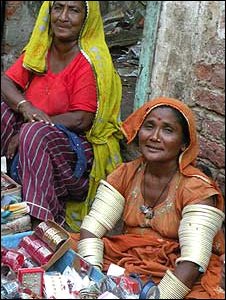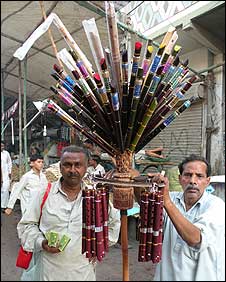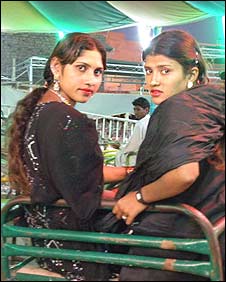
Jodha, a Hindu woman from the nomadic Jogi tribe of snake-charmers, made a vow at the temple of Rama Pir in southern Pakistan that if blessed with a son, she would make a pilgrimage to the temple every year for the rest of her life.
That was just after her wedding, more than four years ago, when her husband took her to the temple fair in Tando Allahyar town of Sindh province.
Her son was born a year later.
Before the partition of India, the Jogis, one of several low caste Hindus, or Dalits, roamed from the Tharparkar desert in Sindh, now Pakistan, to Gujarat and Rajasthan in India.
They still travel vast distances between Sindh's south-western industrial city of Karachi and the agrarian and desert communities they inhabit in the areas eastwards towards the Indian border.
But no matter where she is, when the time comes for the annual fair in honour of Rama Pir, a holy man who lived some 400 years ago, Jodha heads to Tando Allahyar, with her son and husband in tow.
 There is an atmosphere of celebration in the air
There is an atmosphere of celebration in the air
Extra money
The family is among tens of thousands of Dalits that make the pilgrimage.
Some, like Reshma and her family, come to do business that would earn them a little extra money besides paying homage to Rama Pir.
Others combine religious duty with fun and games as an entire amusement park - complete with mechanised merry-go-rounds and roller-coaster rides - appears in an open space behind the temple.
Most of them come to seek deliverance from one worldly ordeal or another.
Basanti, a Dalit woman from the Bheel sub-caste, is childless after three years of marriage.
She has bought several kilograms of sweets from the market outside the temple for distribution among the pilgrims as prasad, or offering.
"I will keep doing it until Rama Pir blesses me with a child; I don't mind if it is a boy or a girl," she says.
'Dalit event'

A chemistry graduate from Tharparkar, Pratap Rai, has been distributing prasad on all three days of the fair for the last five years.
"My brother was critically ill, but he miraculously recovered when I made a vow at the temple that I will offer sweets to pilgrims every year for as long as my legs carry me from Tharparkar to Tando Allahyar," he said.
A good time is had by all
Unlike the vast majority of pilgrims, Pratap Rai is not a Dalit, but an upper caste Brahmin.
According to the Pakistan Hindu Council, there are approximately three million Hindus in Pakistan. Nearly 2.5 million of them live in Sindh province and more than 80% of the total are Dalits.
Local people describe Rama Pir's festival as a nearly exclusive Dalit event, even though the caretaker of the temple is a Brahman.
Arjun Solanki, a local Dalit who is studying medicine at Sindh University, offers an explanation for this.
"Rama Pir was a Dalit convert to the Ismaili Shia faith. He organised lower-caste Hindus against the exploitative Brahmanic and Bania classes of medieval Rajasthan. He was a secular, revolutionary leader," he says.
But after his death, the upper-caste Hindus Brahanised his cult by declaring him as an ethnic Rajput - an upper-caste Hindu warrior clan, says Arjun.
Rama Pir lived and died in Ranuja, a town some 150km (93 miles) from Jodhpur, the capital of Rajasthan.
The temple in Tando Allahyar, according to a local tradition, was built by a native Dalit in the latter half of the 19th Century in fulfilment of a vow he had taken during an earlier pilgrimage to Ranuja.
Like Jodha, he had wished for a son, which was granted to him.


